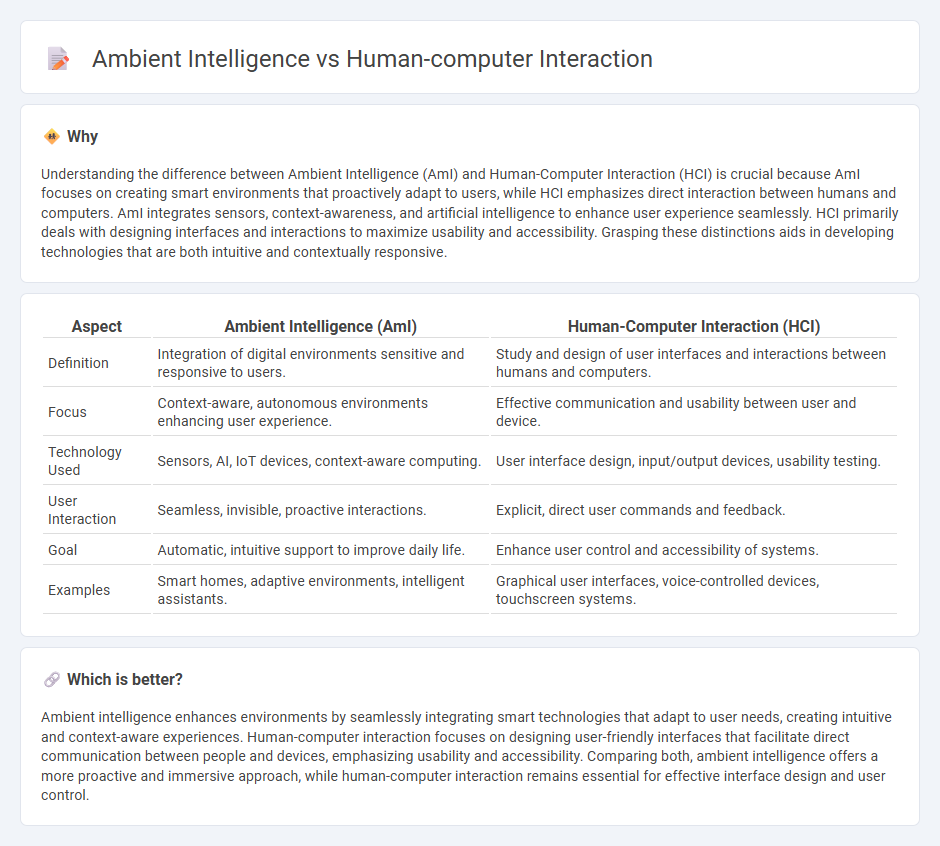
Ambient intelligence integrates embedded sensors and context-aware computing to create environments that adapt seamlessly to user needs, enhancing daily living experiences. Human-computer interaction focuses on designing user interfaces and interactions that facilitate efficient communication between people and devices. Explore further to understand how these technologies are revolutionizing digital experiences.
Why it is important
Understanding the difference between Ambient Intelligence (AmI) and Human-Computer Interaction (HCI) is crucial because AmI focuses on creating smart environments that proactively adapt to users, while HCI emphasizes direct interaction between humans and computers. AmI integrates sensors, context-awareness, and artificial intelligence to enhance user experience seamlessly. HCI primarily deals with designing interfaces and interactions to maximize usability and accessibility. Grasping these distinctions aids in developing technologies that are both intuitive and contextually responsive.
Comparison Table
| Aspect | Ambient Intelligence (AmI) | Human-Computer Interaction (HCI) |
|---|---|---|
| Definition | Integration of digital environments sensitive and responsive to users. | Study and design of user interfaces and interactions between humans and computers. |
| Focus | Context-aware, autonomous environments enhancing user experience. | Effective communication and usability between user and device. |
| Technology Used | Sensors, AI, IoT devices, context-aware computing. | User interface design, input/output devices, usability testing. |
| User Interaction | Seamless, invisible, proactive interactions. | Explicit, direct user commands and feedback. |
| Goal | Automatic, intuitive support to improve daily life. | Enhance user control and accessibility of systems. |
| Examples | Smart homes, adaptive environments, intelligent assistants. | Graphical user interfaces, voice-controlled devices, touchscreen systems. |
Which is better?
Ambient intelligence enhances environments by seamlessly integrating smart technologies that adapt to user needs, creating intuitive and context-aware experiences. Human-computer interaction focuses on designing user-friendly interfaces that facilitate direct communication between people and devices, emphasizing usability and accessibility. Comparing both, ambient intelligence offers a more proactive and immersive approach, while human-computer interaction remains essential for effective interface design and user control.
Connection
Ambient intelligence integrates smart environments with human-computer interaction (HCI) to create adaptive systems that respond seamlessly to user needs. HCI techniques enable intuitive interfaces, allowing ambient intelligence to interpret and anticipate human behavior through sensors and contextual data. This synergy enhances personalized experiences by embedding computing into everyday surroundings for proactive support and interaction.
Key Terms
**Human-computer interaction:**
Human-computer interaction (HCI) explores the design and use of computer technology centered on the interfaces between people and computers, emphasizing usability, accessibility, and user experience. It focuses on optimizing interactions through graphical user interfaces, voice commands, and touch inputs to improve efficiency and satisfaction. Discover how advancements in HCI are shaping future digital experiences and user-centered technologies.
Usability
Human-computer interaction (HCI) emphasizes direct user engagement through intuitive interfaces designed for efficiency and ease of use, while ambient intelligence (AmI) integrates seamless, context-aware technologies that operate unobtrusively in the environment to enhance user experience. Usability in HCI centers on clear feedback mechanisms and user control, whereas AmI prioritizes adaptive responses and anticipatory computing to minimize user effort. Explore more to understand how these paradigms shape future technology design and user satisfaction.
User interface
Human-computer interaction (HCI) emphasizes direct user interface design that prioritizes usability, accessibility, and user feedback through devices like keyboards, mice, and touchscreens. Ambient intelligence (AmI) focuses on creating environments where devices seamlessly respond to user presence and context without explicit interaction, leveraging sensors, AI, and pervasive computing for intuitive interfaces. Explore the evolving impact of HCI and AmI user interfaces on future technology experiences.
Source and External Links
Human-computer interaction - Human-computer interaction (HCI) is the study of how people interact with computer systems, focusing on designing interfaces that allow novel and effective communication between humans and computers, combining insights from computer science and behavioral sciences.
Human-Computer Interaction - HCI is a multidisciplinary field centered on designing, evaluating, and implementing computing systems to facilitate intuitive, efficient, and user-friendly interactions, involving areas like user interface design, user experience, and emerging technologies such as VR and wearables.
What is Human-Computer Interaction (HCI)? | IxDF - HCI emphasizes improving user experience and usability of technology, becoming crucial in a digital age where users can easily switch services, and it involves principles that do not necessarily require coding knowledge but rather focus on design and interaction.
 dowidth.com
dowidth.com